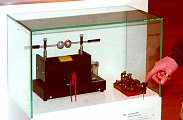
 |
Control of RH and air pollution in showcases |
Absorbent materials such as wood, paper and cotton stabilize the atmosphere of showcases against the relative humidity changes caused by temperature variation and by exchange of air with the surroundings.
There are several exchange processes between the air in the case and the outside air: diffusion through porous coonstruction materials, air flow caused by temperature and pressure changes and air flow by convection in a showcase whose relative humdidity differs from that of it environment. The air changes about once a day in showcases made by conventional joinery techniques. The rate of exchange can be reduced to less than five volumes a year by sealing a showcase so that only one small hole is left for pressure equalization. A dust and sulphur dioxide filter can then be fitted to maintain a pure atmosphere within.
In heated rooms without air conditioning the RH may fall dangerously low in winter. A static method of RH control for showcases is described. This is a saturated solution of sodium bromide covered by a silicone rubber membrane.
A note about the digital version of the article
This article is a scanned pdf version of the article printed in Studies in Conservation 11 (1966) 8 - 30. It shows each page, except the first, as a picture. The photographic illustrations are not well reproduced. As for the content, I would now add that wood is indeed a good humidity buffer, but it outgasses such a variety of chemicals that it should never be used in a sealed container. The appendices about practical experimental methods seem quaint now (June 2004) but give a good impression of the joys of experimental work in the analogue world of the nineteen sixties.
Here is the full article as a pdf file (1.8Mb)

This work is licensed under a Creative Commons Attribution-Noncommercial-No Derivative Works 3.0 License.